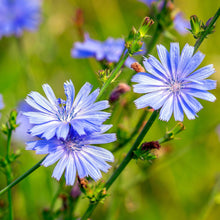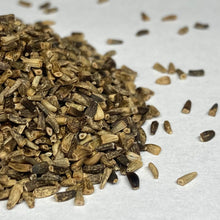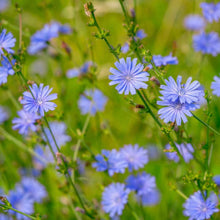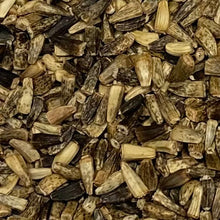*Designated an invasive species in the following states, no sale: AK, CO, NM, KY, WV
Wild Chicory, when flowering in mid to late summer, is a reaching gift of blue-purple blossoms that graces roadsides through much of North America. Known too as succory, this plant is closely related to Dandelion and displays leaves that have a similar appearance. Yet, there can be no confusing the two once the stiff Chicory stalks climb high to set seed, and erupt with an array of flowers. In some places, Cichorium intybus is referred to as ‘Blue Sailors.’ Their flowers only last for one day, opening early in the morning, and fading in the next five hours. By the day’s end, the plant seems to have lost all inflorescence— only to be shrouded in blue the very next morning. They are bee-pollinated, and will gladly take root even in poor soil conditions; their sturdy root system is beneficial in breaking apart compacted soil.
The roots of Chicory are touted as both a herb and a desirable edible; they are best known to be roasted and ground as a coffee substitute, remaining an iconic addition blended into coffee in New Orleans, even long after it had been necessary in the Civil War to stretch limited supply of true coffee beans. This rhizome is known as a ‘prebiotic,’ providing nutrition for beneficial gut bacteria. Its high content of inulin, fiber, and fructose impart it with mild laxative properties. The fructose can be extracted and used as an alternative sweetener. Chicory has the traditional use as a detoxifying agent, especially supportive of cleansing the liver. Second-century physician Galen referred to this plant as a “friend of the liver,” indicating the centuries-long human relationship with Cichorium intybus.
Chicory is a nutritious wild edible, with the vitamin C-rich bitter greens being at their most tender in early spring. Anyone familiar with radicchio, escarole, or endive would recognize the same enticing bitterness of these cultivated vegetables to be found in Wild Chicory, as it is their predecessor. The plant material can be used for a variety of different green or yellow dyes. Early American colonists brought this plant to North America, and it quickly became a notable forage crop for animals. Traditional folklore states that carrying a sprig of chicory can open doors into unseen worlds, and help one forget past loves. With some of these seeds, one can look forward to Chicory love in their future!
“Show me a piece of land that God forgot — /a strip between an unused sidewalk, say,/and a bulldozed lot, rich in broken glass — /and there, July on, will be chicory.” (John Updike)








